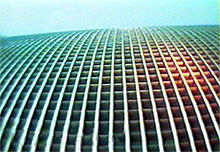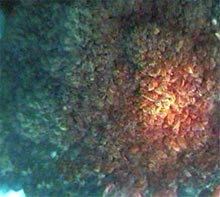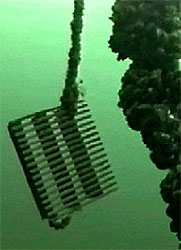July 30, 2009
FOR IMMEDIATE RELEASE
Copper Screens and Coatings Provide a Solution to this $500 million Problem
NEW YORK—Zebra mussels, a tiny species of mollusks that has become a huge problem in U.S. waterways, cause millions of dollars of damage annually. When it comes to dealing with this chronic problem, industry and wildlife experts look to copper with some hope.
Copper screens and copper-based coatings are increasingly being used to block the spread of zebra mussels, according to the Copper Development Association Inc. Why copper? Studies show that zebra mussels don’t attach to copper-nickel alloys.
Threat to Industry, Boating, Navigation
Zebra mussels can cause problems because they attach to almost any hard surface. They may colonize water intake pipes, severely restricting the water flow to power plants or other facilities that rely on fresh water. Their weight can sink navigational buoys. Both large and small boats can be damaged by the increased drag caused by thousands of mussels. And small zebra mussels may get into engine cooling systems, causing overheating and other damage.
The cost of fighting the pests at power plants and other water-consuming facilities is $500 million a year in the U.S., according to according to the Center for Invasive Species Research (CISR) at the University of California, Riverside.
Zebra mussels foul beaches and their sharp shells can cause injury. They also can adversely affect recreational fishing because in some rivers, boaters are restricted from traveling to certain areas in an effort to prevent mussel infestation. Native fish and bird species eat some mussels, but not enough to keep the populations under control.
A Copper Solution

The photo above shows the absence of zebra mussels on a screen made of Z-Alloy material. The photo below shows a stainless steel screen with an infestation of zebra mussels at the J. H. Campbell power plant on Lake Michigan.

For We Energies, copper screens have prevented the spread of zebra mussels into the cooling system of their Oak Creek Power Plant, located on Lake Michigan, about 12 miles south of Milwaukee.
David Lee, manager-water quality for We Energies, said the company had installed the copper-based screens in the United States as part of an ongoing offshore expansion effort. The screens are made of Z-Alloy, a copper-nickel material manufactured by Johnson Screens in Brighton, Minn.
“It’s a proven technology and it works,” said Lee, adding that the Oak Creek Power Plant installed 24 Z-alloy screens in 45 feet of water, about 1 ½ miles from shore. The screens are eight feet in diameter, 35 feet long and placed five feet off the bottom of the lake. It’s the largest number of Z-Alloy screens currently used in a single project in the U.S.
Lee estimated the Z-Alloy screens save Oak Creek Power more than $50,000 annually in zebra mussel clean-up costs.

The screen with the copper-based Jacquelyn Coating has been mussel free for more than six years. Photo courtesy of Cook Legacy Coating Company.
Cook Legacy Coating Company, based in Canal Winchester, Ohio, has created a copper-based coating that’s used in their manufacturing and retrofitting of screens. Jacquelyn Coating eliminates zebra mussels on intake screens, pipe, pump strainers and other equipment. “We feel confident that our recently-coated intake screen will provide the protection necessary to maintain our water production capability,” wrote Michael Sullivan, manager of the Vergennes-Panton Water District Inc. of Vergennes, Vt. Sullivan used the coating on an intake.
Government Officials Propose Change
U.S. Sen. Carl Levin, D-Mich, this month urged two subcommittees of the Senate Environment and Public Works Committee to adopt federal regulations that would require ships to destroy organisms spread by ballast water. Today, almost 30 states are fighting to control and prevent the spread of zebra mussels.
“Because invasive species can quickly spread throughout the country, the best effort that we have against invasive species is prevention,” Levin said at a July hearing. “Maritime commerce is the largest pathway for new species to be introduced into our waters, and I believe that we need to enact legislation that will require ballast water discharge management that will result in ballast water treatment technology onboard ships as soon as possible.”
How Did It Get This Bad?
Geography kept American waterways free of the zebra mussel for centuries. It was confined to waters in Russia and Poland, primarily the Caspian Sea, until trade missions in the early 1800s introduced the mussel to Western Europe. North America was spared until 1988 when authorities suspect a ship dumped infested bilge water into Lake St. Clair. The mussel quickly spread throughout the Great Lakes Region and has spent the last two decades infesting every major river including the Mississippi and Colorado rivers, reaching Southern California in 2008.
The zebra mussel problem in U.S. lakes will have “an environmental impact” regardless of the methods used to eradicate them, said Mike Hoff, regional coordinator for the U.S. Fish and Wildlife Service Aquatic Nuisance Species Program, representing the Great Lakes states.
“There’s no such thing as a copper bullet to correct the problem of zebra mussels,” Hoff said. “But copper can help with the problem – we just need more research.”
Zebra Mussels – What Are They?
- Zebra mussels get their name from the striped pattern of their shells.
- They range from the size of a fingernail to a maximum length of two inches.
- Zebra mussels live four to five years and inhabit fresh water at depths of six to 24 feet.
- A female zebra mussel produces 30,000 to 1 million eggs annually.
- Zebra mussels can colonize a clam shell to the extent a clam cannot open its shell to eat. Some native mussels have been found with more than 10,000 zebramussels attached to them.
- Zebra mussels also can attach to such slow-moving species as crayfish and turtles, in addition to colonizing native mussels and clams.
Sources: www.nationalatlas.gov & http://fl.biology.usgs.gov
Don’t Pick Up Hitchhikers
If you’re boating this summer, try not to pick up zebra mussels and spread them to uninfected waters. Here’s how to avoid hitchhiking zebra mussels, who like to attach to any hard surface, especially boats:
- Learn how to identify a zebra mussel.
- Drain bilge water, live wells, engine cooling systems, bait buckets and any other water from your boat and equipment.
- Inspect your boat’s hull, drive unit, prop guards, anchor and trailer. Scrape off any suspected mussels and vegetation.
- Trash leftover bait. Leftover live bait shouldn’t be taken from infested to uninfected waters.
- Thoroughly flush all boat parts that got wet in infected waters and dry the boat for three to five days before launching.
- Taking your boat to a self-serve car wash may be a convenient way to clean it.
- Remove docks and floats from the water for the winter in order to kill the attached zebra mussels.
- All mussels and plants found attached to your boat should be placed in the trash – not onto the shore or back into the water.
Source: www.lakegeorgeassociation.org
###
